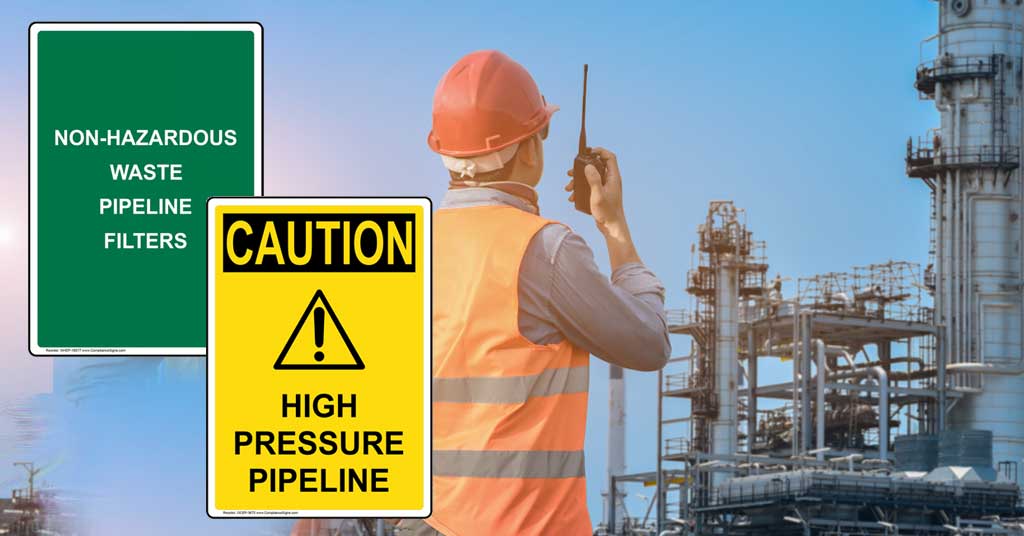
The 5 Must-Have Types of Safety Signage for Pipeline Operations

You may not see them, but pipelines are used in every state in the U.S. They’re used to transport various products, such as oil, gas, and water, over unprecedented distances. The growth of the pipeline network increased in the last few decades, as people’s demand for these products grew. According to the Pipeline and Hazardous Materials Safety Administration (PHMSA), the United States currently has over 2.6 million miles of pipelines for fluid transportation, many of which are buried. Due to their importance in the nation’s infrastructure, protecting and securing the pipeline operators, personnel, and communities against accidents is crucial.
Importance of Safety Signage in Pipeline Operations
Pipeline safety signage plays a critical role in the safety measures employed in pipeline operations. They serve as visual guides to pipeline workers, making them aware of potential hazards, reminding them of crucial safety protocols, and providing emergency evacuation routes. Through safety signs, pipeline personnel can recognize the danger zone, taking precautions before initiating any work activity. Effective safety signage can avert incidents, such as explosions and fires, damaging the products being transported, the pipeline infrastructure, and the environment.
Overview of Must-Have Safety Signs for Pipeline Workers
Based on the nature of the hazards present in the pipeline’s physical environment, OSHA demands five must-have safety signs for pipeline workers. These signs include caution signs, no smoking signs, high voltage warning signs, emergency exit signs, and PPE signs. Pipeline workers must pay attention to these warning signs to avert accidents and adhere to the set safety measures.
Caution signs are designed for pipeline workers to be alert to any potential hazards at their specific work area. They come in yellow or orange background and are highlighted in black letters with a hazard symbol on the left side. They warn workers of an unusually specific type of hazard or situation that requires special attention to maintain safety in their work environment. It is essential to have specific caution signs, such as “Watch Your Step,” “Welding In Progress,” and “Slippery Surface.” According to the PHMSA regulations, employers must place caution signs in areas where there is a possibility of tripping, slipping, or falling and other hazardous activities.
The Transportation Security Administration (TSA) requires that pipeline operators prohibit smoking within a minimum of 50 feet of the pipeline’s operation and maintenance areas. No smoking signs are typically placed in these areas to indicate to workers and visitors where they are prohibited. Smoking near pipelines could trigger explosive accidents, increasing the risk of damaging the pipeline facilities and the surrounding environment. No smoking signs are designed using red and black lettering on a white background to help workers and visitors recognize their purpose. The PHMSA requires that pipeline facilities must have no smoking signs in areas where there is a risk of an ignition source.
Electrical hazards are likely to occur in pipeline environments, with frequent use of electrical equipment. High voltage warning signs are essential for marking areas that pose electrical hazards and reminding workers to take necessary precautions. The warning signs are designed with triangular shapes on a yellow background with black letters. In compliance with OSHA regulations, workers must label the voltage capacity near electrical equipment, transformers, and power stations to reduce the chances of accidental contact with electricity.
Emergency exits should be strategically located in pipeline facilities to help workers exit the area in case of emergencies. The exit signs come in green and white lettering on a rectangular background with arrows pointing to the emergency exit direction. Employers must provide a possible exit route that allows workers to escape to a safe distance during pipeline fires or leaks.
Personal protective equipment (PPE) is essential in pipeline operations to minimize injuries caused by falls, slips, or potential exposure to hazardous chemicals. PPE signs indicate appropriate safety clothing, including eye protection, headgear, gloves, and footwear. The PPE signs come in blue, black, and white lettering on a white background to notify workers when PPE is required to initiate work in specific areas.
Protect Your Workers and the Public
Pipeline operators must make sure that each worker adheres to the best safety practices when working in pipeline environments. The must-have safety signs outlined in this blog, from caution signs, high voltage warnings, no smoking signs, PPE signs, and emergency exit signs, are crucial in ensuring the safety of pipeline workers and the community. By having a proper safety signage program in place, pipeline operators can mitigate the risks associated with pipeline operations. We invite you to browse compliancesigns.com for all your safety signage needs, including customized signs tailored to meet your unique preferences.

